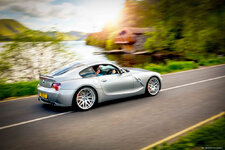You are using an out of date browser. It may not display this or other websites correctly.
You should upgrade or use an alternative browser.
You should upgrade or use an alternative browser.
Spring/Summer 2013 image thread
- Thread starter tomscott
- Start date
tomscott said:Was a gorgeous night couldn't resist, got my dad to drive the car for me
BMW Z4M Coupe, Ulswater Boat house, Cumbria by TomScottPhoto, on Flickr
Learn me how to do THAT with a camera!
ATPDK said:tomscott said:Was a gorgeous night couldn't resist, got my dad to drive the car for me
Learn me how to do THAT with a camera!
Its not too hard, I set the camera at 35mm so you dont get distortion of the car, too wide and the car wont look natural it will bulge at the rear and seem really long at the front, then set the autofocus to AI servo to track the car, high speed burst on the camera which is 6FPS on my 5DMKIII then ISO100, F8 and 1/40sec and I think I added a polariser to reduce the light 3 stops as it was really bright (to get the longer exposure. I set F8 to get the star burst and also to get a longer exposure.
Then I got my dad to drive the car at 15mph (too fast and its hard to pan and the car distorts in the wheels and edges((you can see its doing it ever so slightly at the front as the car naturally changes perspective while panning), then I turned the image stabilisation off on my lens as it will produce an out of focus image because it tries to compensate for the camera moving (my 24-105mm doesnt have a panning IS mode). Then basically you pan with the car, by using your body like a tripod and moving your torso, I practised matching the cars speed for a few runs figuring out the correct setting above. Then just told him to keep going round and round for about 15mins until I was happy I nailed the shot.
It was hard tho because the light kept changing the sun was going in and out. But managed this one towards the end. Its more trail and error than just turing up and shooting 1 or 2 frames.
Then in lightroom I warmed the image up a touch, added a levels adjustment, increased whites blacks and added some shadow recovery, brought it into PS and tidied up some distracting elements then selectively sharpened and thats it.
Although I added that vignette which now I look at it I wish I hadn't as it ruins the top left but never mind. Live and learn
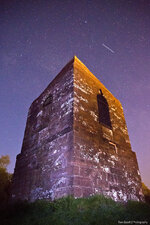
Penrith Beacon, Star gazing by TomScottPhoto, on Flickr
It was the first clear night we have had in a while so I went out at 2am last night, small hike up to the Penrith Beacon.
Penrith Beacon is a monument built in 1719, on a spot where beacons have been lit in times of war and emergency since the time of Henry VIII. Traditionally, the Beacon was used to warn of approaching danger from Scotland.
I didn't really plan on going, more of a last minute decision. But this subject seemed the natural choice being up the road from me, although its high and about a mile from Penrith, there was still light leak from the town which has produced this etherial purple and orange colour cast. Although not technically correct I feel it has enhanced the image.
The image was made possible with the 5DMKIII, it was pitch black and it was shot on a 24-105mm F4 lens. With the incredible ISO capability this was shot at F4 at 16,000ISO!!! with an exposure of 4 seconds so as not to get star trails, although I got a nice shooting star. Then some light was filled by painting with a small torch.
Really pleased with the quality the noise for that sensitivity and duration is really impressive.
Benny88 said:Took these today at 3 sisters sprint track not far away from me, they were all taken on a borrowed (with a view to buy) nikkor 70-300mm lens, I went here to take pics of cars or bikes on the track but there was nothing out today lol, i also knew there was a lake here and hide with bird feeders hanging infront of it to test the lens on its wildlife capabilities too. Its the first time ive used this lens and i made a few mistakes and have learned a lot from today, biggest thing being theres no need to use ISO 2000 to make the exposure right, just shoot underexposed and lighten in photoshop later to avoid excessive noise!
Some nice shots
But you will get more noise by underexposing and recovering the shadows, better off shooting higher ISO depending on your camera. But recovering the shadows by 1-2 stops will increase the noise in the image to a similar level but will the details will be worse, but much harder to repair through noise software.
With birds/animals etc you need to be shooting at least 1/640 to guarantee sharp images so that with say minimum aperture on a 70-300mm at 300mm which im guessing is F5.6? 2000ISO doesn't sound too wrong. Those lamb images were all shot between 1000-2000ISO and there is loads of available light. You learn after a whle that certain animals have certain traits. All sheep grind their teeth if you dont shoot at over 1/1000sec then their face will be blurry. Same with insects they move so quickly that even 1/1000 may not freeze it. I shot some bees yesterday at 1/1200 and the bees were still not sharp because they move too quick.
Most wildlife and track photographers will be anywhere from 640-6400ISO to get a fast enough shutter speed and DOF to freeze the action. Anything up to 6400ISO on full frame cameras is acceptable for publications, crop sensors 3200 is pushing it but is duable as long as its not printed too large.
Bad_Pritt said:I've often wondered whether it's doable to take a decent picture of the moon. I really need to learn and work better with my camera, considering to follow a course... Looking at your pics, I have a LOT to learn!
It certainly is possible
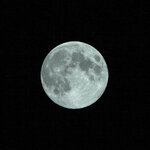
Full Moon - September 2012 by stuart.truman, on Flickr
Bad_Pritt said:I've often wondered whether it's doable to take a decent picture of the moon. I really need to learn and work better with my camera, considering to follow a course... Looking at your pics, I have a LOT to learn!
Here's mine too!

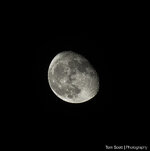
Moon, Largest in 18 years by TomScottPhoto, on Flickr
Hard work shooting the moon because you first need a full moon, clear sky get up really high on like a mountain or fell etc and to aid hopefully a natural phenomenon. Camera wise - a 600mm+ lens also it needs to be a small aperture like F5.6-F8 and high ISO because it moves faster than you think, quick shutter speed to freeze it and get sharp details of the craters etc. Shot this one when the moon was its closest to earth in 18 years March 2011 although I was about a day late because my first attempt was pretty bad, because I had no idea it moved so fast/no idea what I was doing lol! Live and learn again!
http://news.nationalgeographic.co.uk/news/2011/03/110319-supermoon-full-moon-earth-science-space-biggest-closest-brightest/
Was the first time I shot the moon, I used a 100-400mm on a 40D which with the crop gave 640mm, F8, 1/60sec ISO800 and then I cropped well into the image. I should have used around ISO3200 but the 40D high ISO is awful and ISO800 was about as far as I was willing to push it. So underexposed it about a stop (so it would have been like shooting at 1600ISO) and pulled it out in post which worked quite well.
Best settings would be 600mm+ even 800mm at F5.6-8, 1/100-1/400 and around 3200-12800ISO depending how bright it is.
Big lenses cost a lot, extenders can work but they make soft images. Crop cameras can work well because they give you free range x1.6, but high ISO they are not as clean. FF cameras can work too but you need to crop a long way into the image if you don't have anything bigger than 400mm.
Hope that helps
Different approaches. Mine was taken with a 70-200 with my 2x converter on so 400mm. ISO100 and spot metered on the moon. 1/125 at f11.
This was my take on the SuperMoon of 2011. The key difference was this one was 1/350 at f5.6
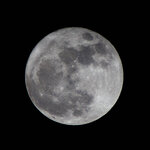
SuperMoon by stuart.truman, on Flickr
This was my take on the SuperMoon of 2011. The key difference was this one was 1/350 at f5.6

SuperMoon by stuart.truman, on Flickr
Similar threads
- Replies
- 14
- Views
- 527




